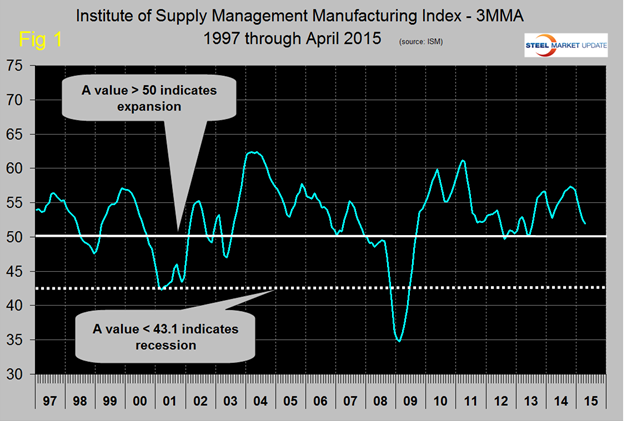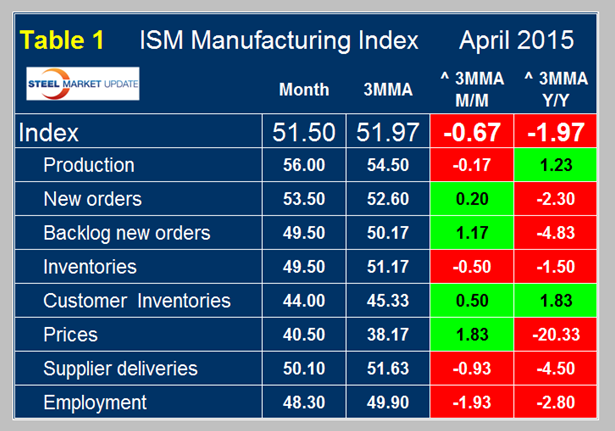Economy

The Pace of Expansion of the ISM Manufacturing Index Continues to Slow
Written by Peter Wright
May 3, 2015
The Institute of Supply Management released their April report on May 1st. An explanation of the ISM index is given at the end of this piece. After the October surprise on the upside, the index slid back to 55.1 in December to 53.5 in January, to 52.9 in February and to 51.5 in March it then was unchanged in April. Any number > 50 indicates expansion but clearly a slowdown is occurring in this index.
The three month moving average has declined for six straight months and now stands at 51.97, which is 3.03 points below the 16 month average since January last year. This was the 31st straight month for which the 3MMA indicated growth (Figure 1).
Headwinds for manufacturing this year have been harsh weather, port disruptions, an appreciating dollar, and a decline in energy-related investment. Some of these issues will be temporary, but they are contributing to a six month slowdown. Next Sunday we will update our detailed report for premium subscribers on the currencies of the steel trading nations. The US $ continues to weaken and is down by 2.52 percent since its recent peak on March 11th.
Table 1 shows the break down for April by sub component with the monthly result, the 3MMA, the growth of the 3MMA m / m and y / y for each. The table shows that the 3MMA y/y growth was negative 1.97 which was the second month of negative growth y/y since March last year.
The good news is that the decline in the 3MMA month over month is slowing. From -1.57 in February to -1.20 in March and -0.67 in April. On a m / m basis, new orders, backlog, customer inventories and prices all improved. The price component in April was down by 20.33 points from this time last year but gained 1.83 points in April. March was the first month for prices to improve since October and April continued that trend. Bad news is that employment has negative growth both on a m / m and y / y basis.
By the measure of the ISM index, manufacturing has slowed this year. The year over year growth of the 3MMA of the Industrial Production Index which is reported by the Federal Reserve slowed from 4.6 percent in January to 4.2 percent in February and 3.3 percent in March. Last month we reserved judgment on whether the expansion of manufacturing is really slowing but based on the latest data from both the ISM and IP indexes this appears to be irrefutable. Please note by no measure are we seeing a contraction, just a slower rate of growth.
The following is the bulk of the report issued by the Institute for Supply Management:
(Tempe, Arizona) — Economic activity in the manufacturing sector expanded in April for the 28th consecutive month, and the overall economy grew for the 71st consecutive month, say the nation’s supply executives in the latest Manufacturing ISM® Report On Business®.
The report was issued today by Bradley J. Holcomb, CPSM, CPSD, chair of the Institute for Supply Management® (ISM®) Manufacturing Business Survey Committee. “The April PMI® registered 51.5 percent, the same reading as in March. The New Orders Index registered 53.5 percent, an increase of 1.7 percentage points from the reading of 51.8 percent in March. The Production Index registered 56 percent, 2.2 percentage points above the March reading of 53.8 percent. The Employment Index registered 48.3 percent, 1.7 percentage points below the March reading of 50 percent, reflecting contracting employment levels from March. Inventories of raw materials registered 49.5 percent, a decrease of 2 percentage points from the March reading of 51.5 percent. The Prices Index registered 40.5 percent, 1.5 percentage points above the March reading of 39 percent, indicating lower raw materials prices for the sixth consecutive month. While the March and April PMI® were equal, both registering 51.5 percent, 15 of the 18 manufacturing industries reported growth in April while only 10 industries reported growth in March, indicating a broader distribution of growth in April among the 18 industries.”
Of the 18 manufacturing industries, 15 are reporting growth in April in the following order: Nonmetallic Mineral Products; Plastics & Rubber Products; Wood Products; Printing & Related Support Activities; Furniture & Related Products; Fabricated Metal Products; Food, Beverage & Tobacco Products; Paper Products; Miscellaneous Manufacturing; Machinery; Transportation Equipment; Textile Mills; Electrical Equipment, Appliances & Components; Chemical Products; and Primary Metals. The two industries reporting contraction in April are: Apparel, Leather & Allied Products; and Computer & Electronic Products.
Explanation; The Manufacturing ISM Report On Business® is published monthly by the Institute for Supply Management™, the first supply institute in the world. Founded in 1915, ISM exists to lead and serve the supply management profession and is a highly influential and respected association in the global marketplace. ISM’s mission is to enhance the value and performance of procurement and supply chain management practitioners and their organizations worldwide. This report has been issued by the association since 1931, except for a four-year interruption during World War II. The report is based on data compiled from purchasing and supply executives nationwide. Membership of the Manufacturing Business Survey Committee is diversified by NAICS, based on each industry’s contribution to gross domestic product (GDP). The PMI is a diffusion index. Diffusion indexes have the properties of leading indicators and are convenient summary measures showing the prevailing direction of change and the scope of change. A PMI™ reading above 50 percent indicates that the manufacturing economy is generally expanding; below 50 percent indicates that it is generally declining. A PMI™ in excess of 42.2 percent, over a period of time, indicates that the overall economy, or gross domestic product (GDP), is generally expanding; below 42.2 percent, it is generally declining. The distance from 50 percent or 42.2 percent is indicative of the strength of the expansion or decline. With some of the indicators within this report, ISM has indicated the departure point between expansion and decline of comparable government series, as determined by regression analysis.

Peter Wright
Read more from Peter WrightLatest in Economy

Architecture billings continue to slide in March
Architecture firms said billings continued to decline in March, according to the latest Architecture Billings Index (ABI) released by the American Institute of Architects (AIA) and Deltek.

Beige Book shows concerns about trade policy
Manufacturing was mixed, but two-thirds of districts said activity was little changed or had declined.

New York state manufacturing index drops again in April
Firms were pessimistic, with the future general business conditions index falling to its second lowest reading in the more than 20-year history of the survey

Construction adds 13,000 jobs in March
The construction sector added 13,000 jobs, seasonally adjusted, in March, but tariffs could undermine the industry.

Supply chains, end-users brace for impact from tariffs
Supply chains are working through what the tariffs mean for them


